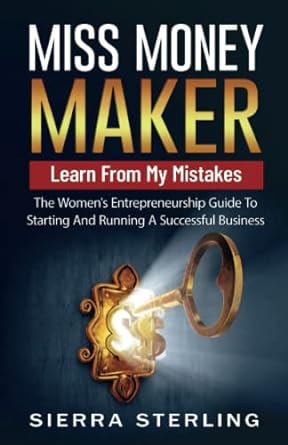Question
Intro: After making some wise short-term investments at a race track, Chris Low had some additional cash to invest in a business. The most promising
Intro: After making some wise short-term investments at a race track, Chris Low had some additional cash to invest in a business. The most promising opportunity at the time was in building supplies, so Low bought a business that specialized in sales of one size of nail. The annual volume of nails was 2,200 kegs, and they were sold to retail customers in an even flow. Low was uncertain how many nails to order at any time. Initially, only two costs concerned him: order-processing costs, which were $52 per order without regard to size, and warehousing costs, which were $1.52 per year per keg space. This meant that Low had to rent a constant amount of warehouse space for the year, and it had to be large enough to accommodate an entire order when it arrived. Low was not worried about maintaining safety stocks, mainly because the outward flow of goods was so even. Low bought his nails on a delivered basis.
****(I need to answer these questions and show the formulas in each cell, thank you).****
Please answer these 2 questions:
5. Temporarily, ignore your work on Questions 2, 3, and 4. Lows luck at the race track is over; he now must borrow money to finance his inventory of nails. Looking at the situation outlined in Question 1, assume that the wholesale cost of nails is $42 per keg and that Low must pay interest at the rate of 1.3% per month on unsold inventory. What is his new EOQ and how has his Total inventory costs changed? Discuss how this situation is different from when you used company cash-on-hand to purchase inventory in the past.
6. Taking into account all the factors listed in Questions 1, 2, 3, and 5, calculate Lows EOQ for kegs of nails. Given the new Cost of Capital, should Mr. Low still take the supplier rebate and new warehouse offer? How much do these now save him? Which of these 6 EOQs are correct? What is your final recommendation to Mr. Low?
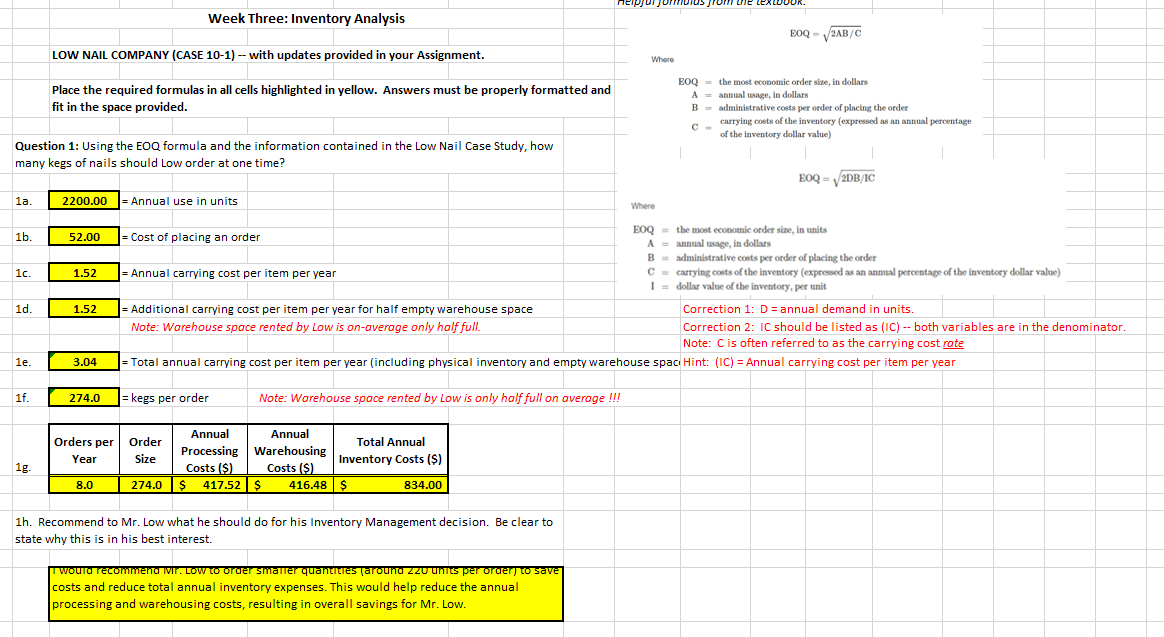
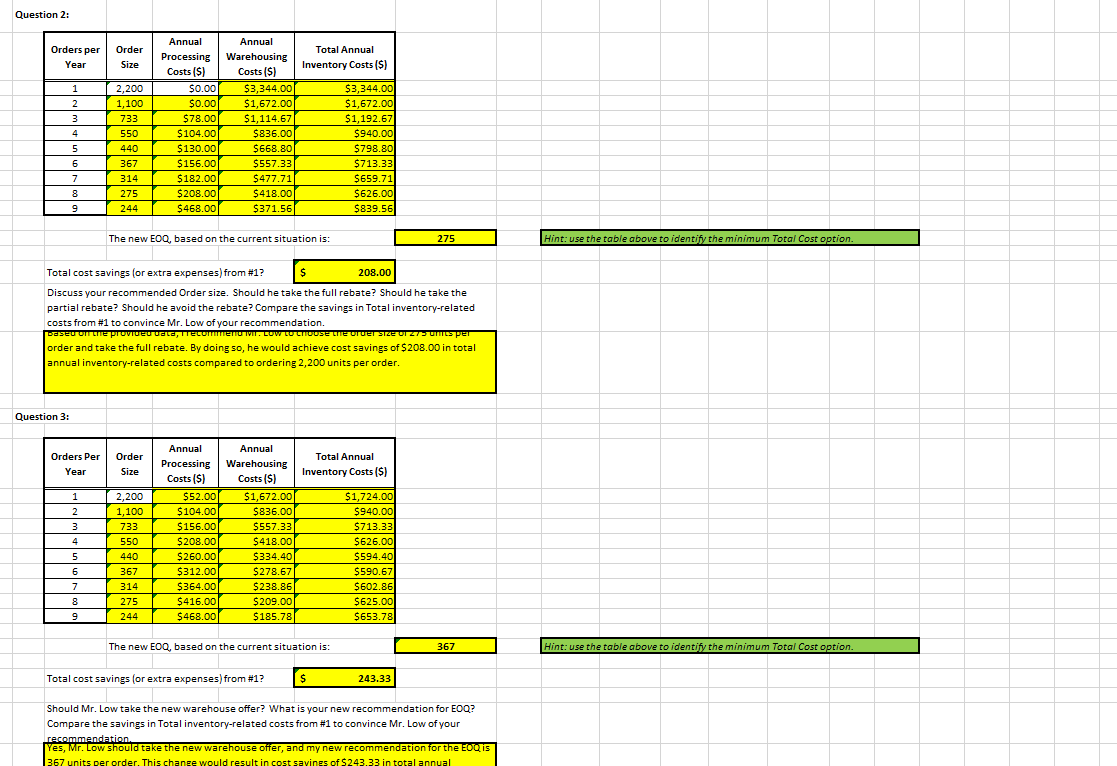
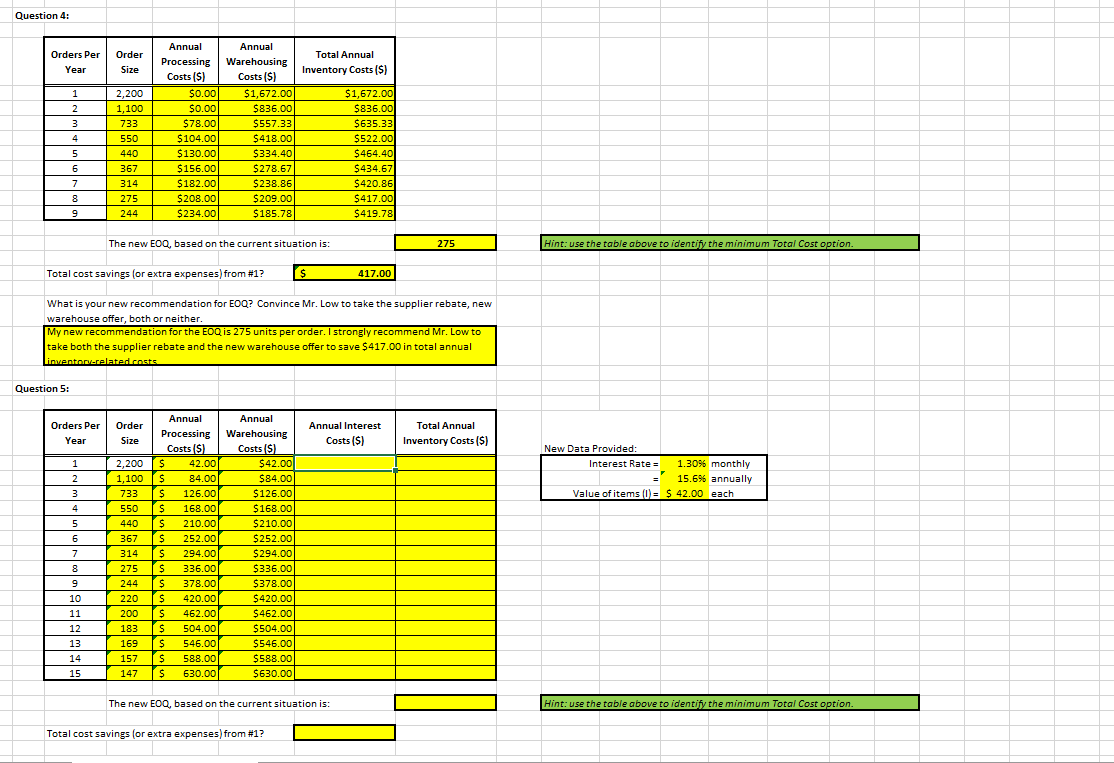
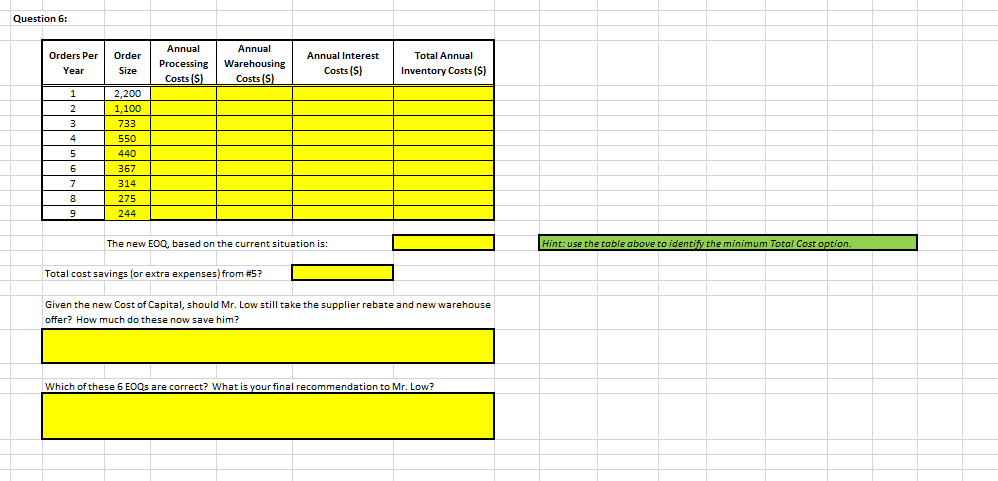 Week Three: Inventory Analysis LOW NAIL COMPANY (CASE 10-1) - with updates provided in your Assignment. Place the required formulas in all cells highlighted in yellow. Answers must be properly formatted and fit in the space provided. Question 1: Using the EOQ formula and the information contained in the Low Nail Case Study, how many kegs of nails should Low order at one time? 1b. 1c. 1d. Where EOQ=2AB/C EOQ=themosteconomicordersive,indollarsA=annualusage,indollarsB=administrativecostsperorderofplacingtheordercarryingcostsoftheinventory(expressedasanannualpercentageoftheinventorydollarvalue) EOQ=2DB/IC Where EOQ = the moet economic order stiee, in units A=annualnsage,indollars B= administrative costs per order of placing the order C= carrying costs of the inventory (expresed as an annual perentage of the inventory dollar value) I = dollar value of the inventory, per unit Correction 1: D= annual demand in units. Correction 2: IC should be listed as (IC) - both variables are in the denominator. Note: C is often referred to as the carrying cost rate 1e. 3.04 = Total annual carrying cost per item per year (including physical inventory and empty warehouse spac Hint: (IC) = Annual carrying cost per item per year 1g. Additional carrying cost per item per year for half empty warehouse space Note: Warehouse space rented by Low is on-average only half full. 1h. Recommend to Mr. Low what he should do for his Inventory Management decision. Be clear to state why this is in his best interest. Twould ecommendivir. Low to order smatrer quamtitres faround LZU Uhits per orderf to save costs and reduce total annual inventory expenses. This would help reduce the annual processing and warehousing costs, resulting in overall savings for Mr. Low. Question 2: The new EOQ, based on the current situation is: 275 Total cost savings (or extra expenses) from \#1? $208.00 Discuss your recommended Order size. Should he take the full rebate? Should he take the partial rebate? Should he avoid the rebate? Compare the savings in Total inventory-related costs from #1 to convince Mr. Low of your recommendation. annual inventory-related costs compared to ordering 2,200 units per order. Question 3: \begin{tabular}{|c|c|r|r|r|} \hline OrdersPerYear & OrderSize & AnnualProcessingCosts($) & AnnualWarehousingCosts($) & TotalAnnualInventoryCosts($) \\ \hline \hline 1 & 2,200 & $52.00 & $1,672.00 & $1,724.00 \\ \hline 2 & 1,100 & $104.00 & $836.00 & $940.00 \\ \hline 3 & 733 & $156.00 & $557.33 & $713.33 \\ \hline 4 & 550 & $208.00 & $418.00 & $626.00 \\ \hline 5 & 440 & $260.00 & $334.40 & $594.40 \\ \hline 6 & 367 & $312.00 & $278.67 & $590.67 \\ \hline 7 & 314 & $364.00 & $238.86 & $602.86 \\ \hline 8 & 275 & $416.00 & $209.00 & $625.00 \\ \hline 9 & 244 & $468.00 & $185.78 & $653.78 \\ \hline \end{tabular} The new EOQ, based on the current situation is: 367 Total cost savings (or extra expenses) from \#1? $243.33 Should Mr. Low take the new warehouse offer? What is your new recommendation for EOQ? Compare the savings in Total inventory-related costs from #1 to convince Mr. Low of your recommendation. Yes, Mr. Low should take the new warehouse offer, and my new recommendation for the eodis
Week Three: Inventory Analysis LOW NAIL COMPANY (CASE 10-1) - with updates provided in your Assignment. Place the required formulas in all cells highlighted in yellow. Answers must be properly formatted and fit in the space provided. Question 1: Using the EOQ formula and the information contained in the Low Nail Case Study, how many kegs of nails should Low order at one time? 1b. 1c. 1d. Where EOQ=2AB/C EOQ=themosteconomicordersive,indollarsA=annualusage,indollarsB=administrativecostsperorderofplacingtheordercarryingcostsoftheinventory(expressedasanannualpercentageoftheinventorydollarvalue) EOQ=2DB/IC Where EOQ = the moet economic order stiee, in units A=annualnsage,indollars B= administrative costs per order of placing the order C= carrying costs of the inventory (expresed as an annual perentage of the inventory dollar value) I = dollar value of the inventory, per unit Correction 1: D= annual demand in units. Correction 2: IC should be listed as (IC) - both variables are in the denominator. Note: C is often referred to as the carrying cost rate 1e. 3.04 = Total annual carrying cost per item per year (including physical inventory and empty warehouse spac Hint: (IC) = Annual carrying cost per item per year 1g. Additional carrying cost per item per year for half empty warehouse space Note: Warehouse space rented by Low is on-average only half full. 1h. Recommend to Mr. Low what he should do for his Inventory Management decision. Be clear to state why this is in his best interest. Twould ecommendivir. Low to order smatrer quamtitres faround LZU Uhits per orderf to save costs and reduce total annual inventory expenses. This would help reduce the annual processing and warehousing costs, resulting in overall savings for Mr. Low. Question 2: The new EOQ, based on the current situation is: 275 Total cost savings (or extra expenses) from \#1? $208.00 Discuss your recommended Order size. Should he take the full rebate? Should he take the partial rebate? Should he avoid the rebate? Compare the savings in Total inventory-related costs from #1 to convince Mr. Low of your recommendation. annual inventory-related costs compared to ordering 2,200 units per order. Question 3: \begin{tabular}{|c|c|r|r|r|} \hline OrdersPerYear & OrderSize & AnnualProcessingCosts($) & AnnualWarehousingCosts($) & TotalAnnualInventoryCosts($) \\ \hline \hline 1 & 2,200 & $52.00 & $1,672.00 & $1,724.00 \\ \hline 2 & 1,100 & $104.00 & $836.00 & $940.00 \\ \hline 3 & 733 & $156.00 & $557.33 & $713.33 \\ \hline 4 & 550 & $208.00 & $418.00 & $626.00 \\ \hline 5 & 440 & $260.00 & $334.40 & $594.40 \\ \hline 6 & 367 & $312.00 & $278.67 & $590.67 \\ \hline 7 & 314 & $364.00 & $238.86 & $602.86 \\ \hline 8 & 275 & $416.00 & $209.00 & $625.00 \\ \hline 9 & 244 & $468.00 & $185.78 & $653.78 \\ \hline \end{tabular} The new EOQ, based on the current situation is: 367 Total cost savings (or extra expenses) from \#1? $243.33 Should Mr. Low take the new warehouse offer? What is your new recommendation for EOQ? Compare the savings in Total inventory-related costs from #1 to convince Mr. Low of your recommendation. Yes, Mr. Low should take the new warehouse offer, and my new recommendation for the eodis Step by Step Solution
There are 3 Steps involved in it
Step: 1

Get Instant Access to Expert-Tailored Solutions
See step-by-step solutions with expert insights and AI powered tools for academic success
Step: 2

Step: 3

Ace Your Homework with AI
Get the answers you need in no time with our AI-driven, step-by-step assistance
Get Started


